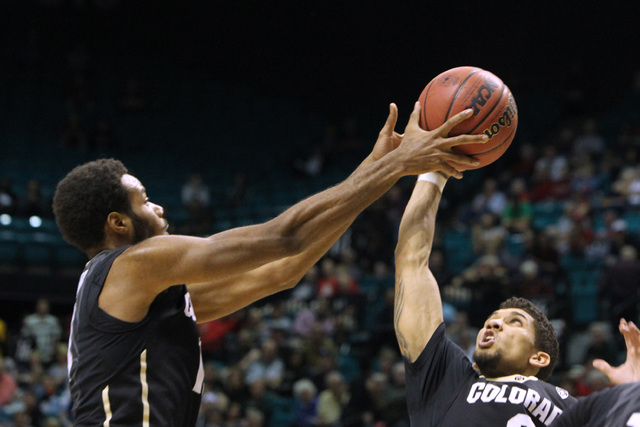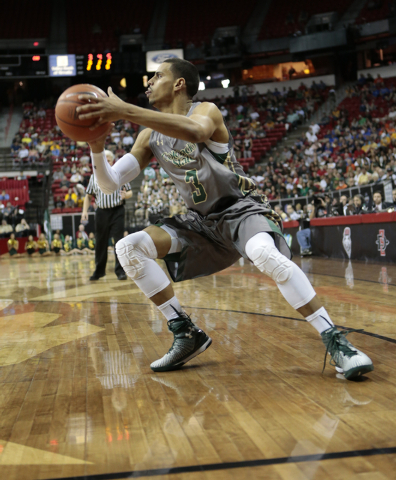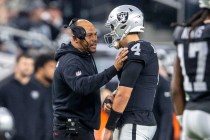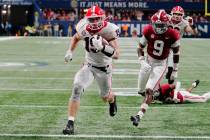Rams now know it’s more than your RPI
Larry Eustachy was convinced, adamant, certain of his basketball team’s fate.
It wasn’t false bravado, either.
He truly believed.
“We’re not on the bubble,” Eustachy said late Friday, his Colorado State side having just lost to San Diego State in a Mountain West Tournament quarterfinal at the Thomas &Mack Center. “I’ve been through this a lot, and we’re squarely in the NCAA Tournament. I’ve been wrong once in my life before, but only once ...
“It’s kind of a moot deal. We’re far too deep into it. I have no doubt we are in based on what the criteria is. The people who know, the experts who do this for a living, you know, we’re in great shape.”
Here’s what they are today: A No. 1 seed ... in the National Invitation Tournament.
For some time now, there has been this feeling around college basketball that those who form the NCAA Tournament Selection Committee would rely less and less on the metric that is the Ratings Percentage Index, that those who play the RPI game when forming a nonconference schedule in order to position themselves for an at-large berth might one day lose big time.
Colorado State is arguably the best example we have had on this theory.
The Rams played the RPI schedule game.
They lost big time.
The cover of the book that defines CSU’s season would be bright and impressive, highlighted by a 27-6 record and an RPI of 30. But once you sat down and opened it and began reading, you suddenly would become aware of those shortcomings the committee held against CSU.
“(CSU) fell short in other metrics we use besides the RPI,” said Utah State athletic director and selection committee chairman Scott Barnes. “We use RPI as an organizer but also use Kenpom and Sagarin and the Basketball Power Index in the room. Colorado State had no true road wins against the top 100 teams. That was a factor.”
How the RPI game is played: You schedule home games against good but not great teams like Montana and Georgia State and Mercer and Texas El-Paso and Northern Colorado, teams with little chance to win in Fort Collins. You begin the season 14-0 and everything looks rosy.
But your best neutral court win eventually becomes UC Santa Barbara.
Your best true road win is New Mexico State.
Your best true road win under 3,500 feet is Fresno State.
There’s not much to any of that, except a lot of empty calories.
Which is why CSU’s rating on Kenpom was 68 and that 18 teams above it also didn’t make the NCAAs.
Which brings up a more pressing issue: Mountain West scheduling and how it led to the worst season in league history.
This conference needs to take a good, hard, long look at itself when it comes to who its basketball teams encounter before league play begins. It sent three teams into the NCAAs this year but only because Wyoming (a No. 12 seed in the East Region) upset San Diego State (a No. 8 in the South Region) in the league tournament final Saturday.
Boise State also made the field. It was slated in a No. 11 play-in game against Dayton ... in Dayton.
The committee showed no respect for the Mountain West, deservedly so when you consider it ranked as the nation’s No. 11 conference. And if the membership doesn’t begin taking steps to improve nonleague scheduling, things might not change.
There is value to shortening the league schedule from 18 to 16 games to allow for more nonconference opportunities. There is much truth in that the proposed revival of a Mountain West-Missouri Valley challenge makes zero sense unless you’re gong to make certain lower teams (see San Jose State, Air Force and UNR) play some of the better ones from the opposing league.
UNLV and San Diego State already schedule tough. They don’t need the RPI help others in the Mountain West do.
This is, if anything, a wake-up call for the Mountain West, because while the book cover might be bright and impressive, the committee Sunday proved it’s going to begin reading each chapter to see what’s really inside.
CSU wasn’t even the last at-large team considered. Temple was but lost its berth when Wyoming earned the Mountain West’s automatic bid and, as Barnes put it, the Owls had bad losses to “UNLV and St. Joe’s.”
That’s what the Rebels have become.
They’re now a bad loss for a bubble team.
CSU, on the other hand, is in ... as a No. 1 seed in the NIT that opens play against South Dakota State.
It’s not how the Rams planned things.
“I don’t want to say something I’m going to regret,” Eustachy told reporters when not taking questions following the NCAA field being announced. “The disappointment is that I’ve got 12 players in that (locker room) crying. We are one of the best 68 teams in the country. The committee didn’t feel that way. Our team moves on. I just can’t say anything more right now. I have a team to console. They are devastated and should be. They are certainly an NCAA Tournament team.”
Not by the metrics used in the room.
Which means, less and less, the RPI is an end-all to at-large selections.
Las Vegas Review-Journal sports columnist Ed Graney can be reached at egraney@reviewjournal.com or 702-383-4618. He can be heard from 11 a.m. to 2 p.m. Monday through Friday on “Gridlock,” ESPN 1100 and 100.9 FM. Follow him on Twitter: @edgraney.























